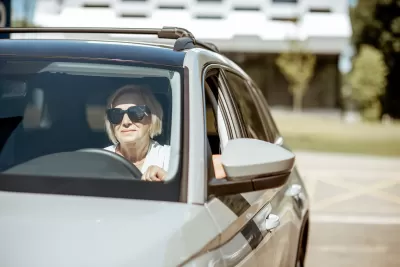Limited transit options and a lack of walkability mean more older Americans will continue to drive their cars as they age.

A survey conducted by the AARP reveals that many older Americans don’t believe they’ll ever have to stop driving, according to an article by Lloyd Alter.
The survey finds that adults 50-plus expect to make changes as they age, including bathroom changes and even anticipate the need for ramps and chair lifts. But there is no mention anywhere of the most significant and dramatic change in people’s lives as they age: the ability to drive.
Studies have found that older drivers can expect roughly seven to 11 years of life after driving becomes difficult or impossible. “That might mean 11 years of failing health in a single-family house in the suburbs, without a car, without family nearby, and without being in a walkable neighborhood.” And a 2020 study found a preference for personal vehicles even when public transit is available. “As a result, driving is synonymous with personal transportation mobility, and driving cessation is associated with loss of independence combined with becoming a burden to family and friends,” that study noted.
The AARP survey includes recommendations for how communities can better accommodate older residents and provide alternatives to driving. For Alter, “We need accessible housing, and walkable communities with good sidewalks, corner stores, medical facilities and coffee shops within a reasonable distance. We need good safe accessible transit for when we have to go further. We all must prepare for a non-driving future.”
FULL STORY: Survey: Boomers Don’t Accept That They Won’t Be Able To Drive Forever

Trump Administration Could Effectively End Housing Voucher Program
Federal officials are eyeing major cuts to the Section 8 program that helps millions of low-income households pay rent.

Planetizen Federal Action Tracker
A weekly monitor of how Trump’s orders and actions are impacting planners and planning in America.

Ken Jennings Launches Transit Web Series
The Jeopardy champ wants you to ride public transit.

California Invests Additional $5M in Electric School Buses
The state wants to electrify all of its school bus fleets by 2035.

Austin Launches $2M Homelessness Prevention Fund
A new grant program from the city’s Homeless Strategy Office will fund rental assistance and supportive services.

Alabama School Forestry Initiative Brings Trees to Schoolyards
Trees can improve physical and mental health for students and commnity members.
Urban Design for Planners 1: Software Tools
This six-course series explores essential urban design concepts using open source software and equips planners with the tools they need to participate fully in the urban design process.
Planning for Universal Design
Learn the tools for implementing Universal Design in planning regulations.
Ada County Highway District
Clanton & Associates, Inc.
Jessamine County Fiscal Court
Institute for Housing and Urban Development Studies (IHS)
City of Grandview
Harvard GSD Executive Education
Toledo-Lucas County Plan Commissions
Salt Lake City
NYU Wagner Graduate School of Public Service





























